#In Search of the Indo-Europeans
Text
Interestingly enough, the zaltys, the Lithuanian green snake, occupied an extraordinarily important role in pagan Lithuanian belief as well as folklore. We read how each household maintained its own snake, and contemporary accounts of the forced Christianization of the Balts by their German neighbours report how the Germans seized the snakes against great protest and burnt them in public bonfires in the middle of the Baltic villages.
#This is genuinely sad#Lithuania#paganism#In Search of the Indo-Europeans#J.P.Mallory#history#medieval#txt
16 notes
·
View notes
Text
Doing research for a conlang
search: indo-european consonant shifts
results: Grimm's law, Grimm's law, nothing but Grimm's law, Germanic languages are the only ones that exist, don't even bother asking about anything else
search: indo-iranian consonant shifts
results: here's a map of Iran, here's ten thousand maps of Iran, and here's a chart of the Persian writing system. How about Indian food near you?
search: proto-indo-european daughter language sound shifts
results: GRIMM'S LAW BABY!!! And here's a map of Eurasia from Wikipedia for your troubles. Fuck you.
I checked; my library district has exactly ZERO books on any of the subjects I'm looking for across 12 branches throughout the entire county. Remember when the internet was the information super highway? I may as well be asking random strangers off the street!
#research#conlang#pie#proto indo european#indo european#linguistics#dead internet#google doesn't work#I haven't used it in months#but duckduckgo isn't any better#no search engines work anymore#I've tried ask and bing and yahoo but they all just show me the same shit as google with different ads based on the parent company#enshittification
34 notes
·
View notes
Text
firefly..?
#itlogthoughts#like. you know how ellie is literally the embodiment of light#and how miss lightkeeper (i'll just call her that from now on) love love loves bugs#the mirror calls ellie “little firefly” at one point so it works..? but the tag needs to be unique so this isn't it#my first thought was lightbug which is...😭️😭️#all of the things i'm thinking of involve “light” and “bug” instead of dragon. sorry miss lightkeeper you're a cockroach to me now#considering luxdragon but that's a fanficiton author's name so. no.#amidst my searching apparently the word “dragon” was derived from the Proto-Indo-European prefix “derk-”#which was then used to derive the words “zoraht” (Old High German) and “dritë”(Albanian) which both mean light in their respective language#i'm not a linguist but. but. come on. look. they're meant for each other i'm going crazy#still no luck with coming up with a funny ship name though.#considering “leukdraco” as a ship tag but i mashed two words together who come from two different languages and i might get murdered#by a linguist. sorry latin enthusiast mutual
1 note
·
View note
Text
I just heard Neil Gaiman (I’m not @ tagging him on purpose, don’t want to spam him) talking on a podcast about the origins of the word “bagel” and it’s gone off into the weeds (it’s No Such Thing As a Fish, so it’s kinda weedy anyway) on the origins of the word “lox” so I did some light searching around and holy shit. That last line goddamn.

So this word “lox” that English borrowed pretty recently from Yiddish, is so stable that is was probably pronounced the same way and referred to the same thing (salmon) 8000 fucking years ago when Proto Indo European was a spoken language.
Fucking cool. And as an American Jew I feel like bagels and lox are an essential part of my cultures foodways so it’s interesting to learn that the words have such history.
I’m choosing to interpret this as humans being fucking into smoked salmon since the jump, mostly because I love smoked salmon of all kinds, including super salty lox so it gotta be a universal human truth of course
#lox#bagel#no such thing as a fish#neil gaiman#word origins#jumblr#Yiddish#food#cooking#bagel and lox#etymology
148 notes
·
View notes
Text
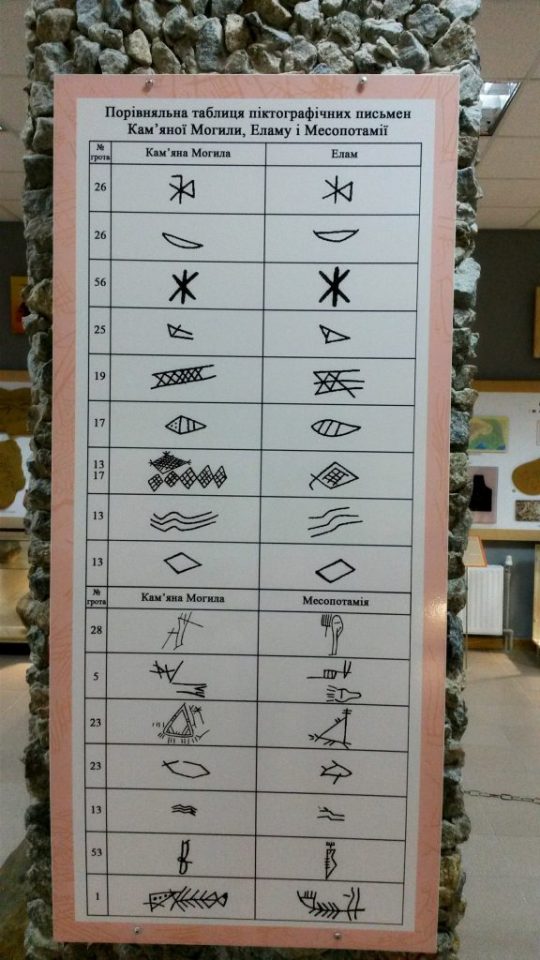


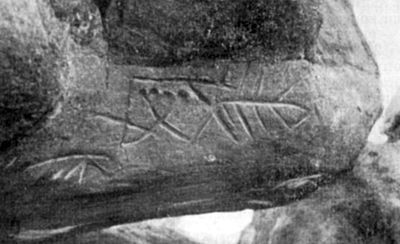
Kamyana Mohyla is believed to contain the first writing in the world.
According to the Ukrainian scientist I. M. Rassokha, most of the inscriptions of Kamyana Mohyla have direct parallels with the ancient Ogamic inscriptions of the British Isles, Germanic "coniferous" runes, ancient Slavic "strokes and cuts", etc., that is, it can be a monument of the most ancient sacred writing of the era of Indo-European unity, namely the Seredniy Stog culture of the 4th millennium BC.
The famous linguist N. Marr proved that the Ukrainian verb "to search" (шукати - shukaty) comes from the Sumerian "shu" - "hand". The Kyivan researcher S. Paukov believes that the Ukrainian words "shana" (honour) and "shanuvaty" (to pay respect) also came from the Sumerian "Shu-Nun" (which is believed to mean "the hand of the queen).
The Sumerologist A.G. Kyfishyn studied the inscriptions of the Kamyana Mohyla (VII-III millennia BC) for a long time and found many parallels with inscriptions on clay tablets of the civilizations of Elam and Mesopotamia (Sumeria): This "writing", as he believes, was invented by the "proto-Sumerians" who lived in "Ukrainian Aratta" as early as the 12th millennium BC, and from there this ancient ethnic group apparently moved to Mesopotamia after the flooding of the Northern Black Sea, which, according to G.A. Kyfishyn, reflected in the biblical message about the World Flood.
Kamyana Mohyla has been occupied by russians since 2022.
123 notes
·
View notes
Text
In reaction to this post, @irlactualwizard wrote:
This is beautiful.
On the note about maces and the like, they're traditionally horseback weaponry. I'm unsure of the usefulness or practicality of a dagger tucked away in a weapon primarily used from 'higher ground' or where CQC wouldn't be common. I mean, fall off the horse, drop the mace and draw the saber or katar.
Although, redundancy is what keeps humans alive. It does strike me as odd that they wouldn't have shoved an extra weapon in just for the niche.
That notion of dropping the mace then drawing something else with longer (or for really close quarters, shorter) reach is something which may well have happened, though not just because it was an exclusively cavalry weapon. All the other weapons were also used from horseback, and in one instance its original Indo-Persian name is pretty specific about equestrian origins.
The zaghnal, that wicked pick-axe thing...
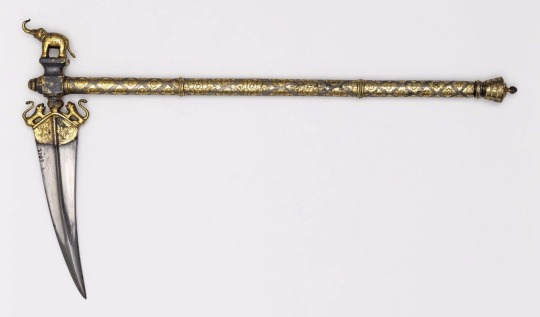
(yup, there's a dagger...)
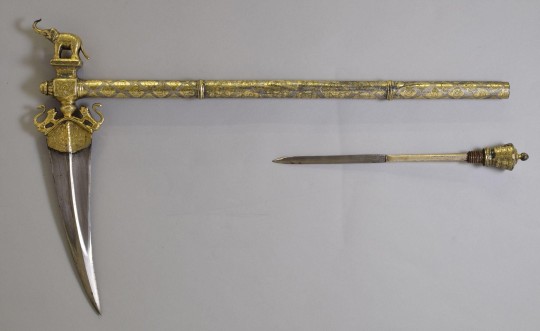
...has a European equivalent called a "horseman's pick" and supposedly copied from Ottoman weapons which would have been zaghnal-shaped; this one is Polish or Hungarian...

The hatchet-knife bhuj was - per Wikipedia, Bygone Blades and Oriental Arms - a popular weapon with the Gujarati and Sindhi cavalry, who also wore a distinctive style of full armour...
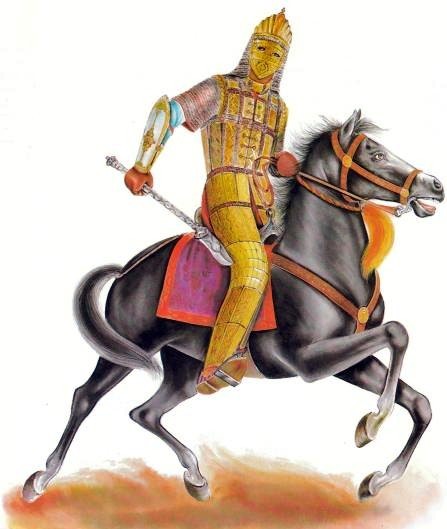
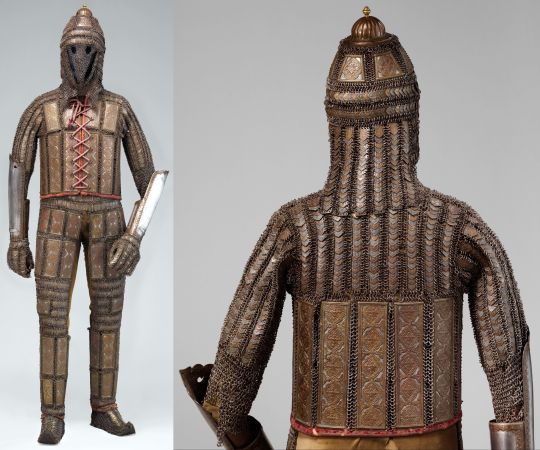

(yup, there's a dagger)

(This time there's a gun, and probably a dagger too because why not?)

Most conclusively, the proper name for Indo-Persian battleaxes is tabar / tabarzin, which means "saddle-axe".
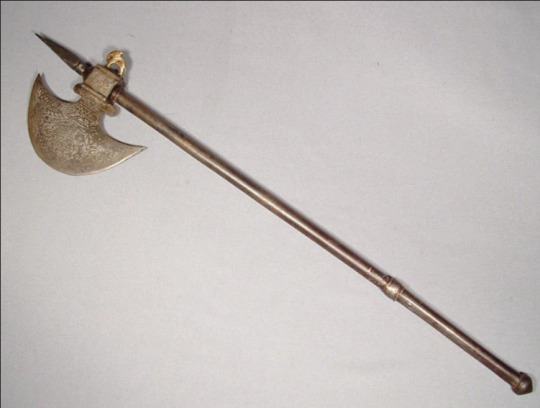
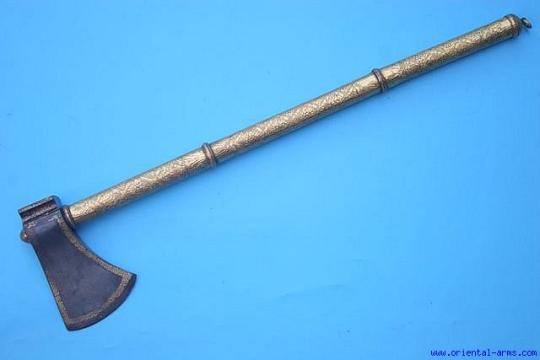
These included some of the few real-life examples of double-headed battleaxes (with daggers, but of course...)


Though popular in fantasy art, IRL usual practice was to have an axe on one side and something different like a hammer or pick on the other side in case the axe wasn't effective enough against whatever kind of armour the opponent was wearing.
And of course even single-headed axes often had the usual dagger tucked away.

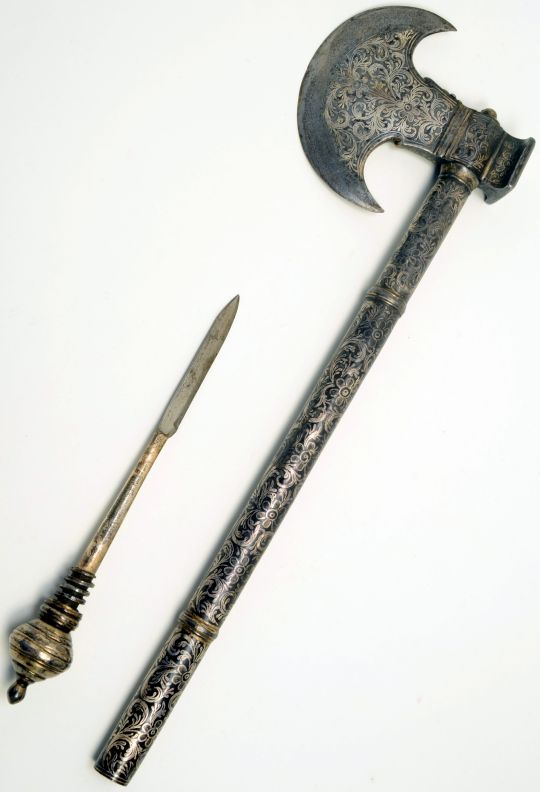
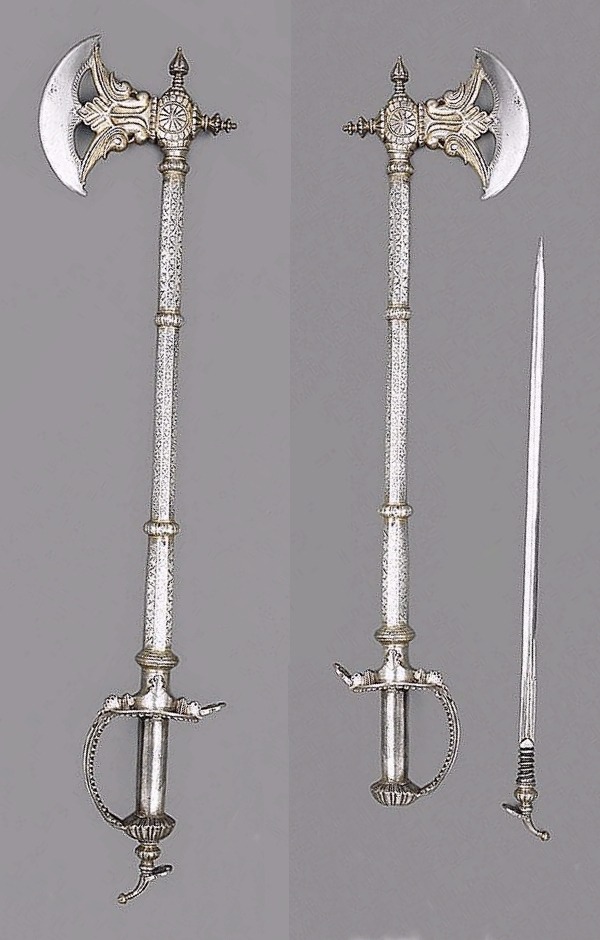
Here's yet another with a sword-hilt (also possibly a dagger) and a built-in matchlock gun...

And here's one where some warrior just couldn't make up his mind.

Here's a mace with a similar (khanda broadsword) hilt:

I took a close look at various mace-pics I've posted (here and here), something I should have done before, then searched further on-line, and I'm starting to think they had no daggers because mostly their hafts were solid rather than hollow...

Thanks go to @irlactualwizard for prompting me to track down an answer to my own question - though I'll be waiting for someone who knows far more about Indian weapons to correct me. :-P
Finally, here's a display case showing three more maces, a couple of the double- (here triple-) -bladed daggers called haladie, and a few examples of what Indian weaponsmiths could do with the basic concept of a sword blade...

...including making use of a European hilt, top row second left. Its blade may have been mounted on an Indian khanda or talwar hilt, which happened often enough to create a whole class of "firangi" (Frankish) swords.
There are many more pics on my blog and elsewhere. Once again, for fantasy edged-weapon inspirations, India is a great place to start...
:->
158 notes
·
View notes
Text
Blackcrowing's Master Reading List

I have created a dropbox with pdfs I have gathered over the years, I have done my best to only allow access to documents which I found openly available through sites like JSTOR, Archive.org, or other educational resources with papers available for download.
That being said I ALSO recommend (I obviously have not read all of these but they are either in my library or I intend to add them)
📚 Celtic/Irish Pagan Books
The Morrighan: Meeting the Great Queens, Morgan Daimler
Raven Goddess: Going Deeper with the Morríghan, Morgan Daimler
Irish Paganism: Reconstructing Irish Polytheism, Morgan Daimler
Ogam: Weaving Word Wisdom, Erynn Rowan Laurie
Celtic Cosmology and the Otherworld: Myths, Orgins, Sovereignty and Liminality, Sharon Paice MacLeod
Celtic Myth and Religion, Sharon Paice MacLeod
A Guide to Ogam Divination, Marissa Hegarty (I'm leaving this on my list because I want to support independent authors. However, if you have already read Weaving Word Wisdom this book is unlikely to further enhance your understanding of ogam in a divination capacity)
The Book of the Great Queen, Morpheus Ravenna
Litany of The Morrígna, Morpheus Ravenna
Celtic Visions, Caitlín Matthews
Harp, Club & Calderon, Edited by Lora O'Brien and Morpheus Ravenna
Celtic Cosmology: Perspectives from Ireland and Scotland, Edited by Jacqueline Borsje and others
Polytheistic Monasticism: Voices from Pagan Cloisters, Edited by Janet Munin
📚 Celtic/Irish Academic Books
Early Medieval Ireland 400-1200, Dáibhí Ó Cróinín
The Sacred Isle, Dáithi Ó hÓgáin
The Ancient Celts, Berry Cunliffe
The Celtic World, Berry Cunliffe
Irish Kingship and Seccession, Bart Jaski
Early Irish Farming, Fergus Kelly
Studies in Irish Mythology, Grigory Bondarnko
Prehistoric Archaeology of Ireland, John Waddell
Archeology and Celtic Myth, John Waddell
Understanding the Celtic Religion: Revisiting the Past, Edited by Katja Ritari and Alexandria Bergholm
A Guide to Ogam, Damian McManus
Cesar's Druids: an Ancient Priesthood, Miranda Aldhouse Green
Animals in Celtic Life and Myth, Miranda Aldhouse Green
The Gods of the Celts, Miranda Green
The Celtic World, Edited by Miranda J Green
Myth and History in Celtic and Scandinavian Tradition, Edited by Emily Lyle
Ancient Irish Tales, Edited by Tom P Cross and Clark Haris Slover
Cattle Lords and Clansmen, Nerys Patterson
Celtic Heritage, Alwyn and Brinley Rees
Ireland's Immortals, Mark Williams
The Origins of the Irish, J. P. Mallory
In Search of the Irish Dreamtime, J. P. Mallory
The Táin, Thomas Kinsella translation
The Sutton Hoo Sceptre and the Roots of Celtic Kingship Theory, Michael J. Enright
Celtic Warfare, Giola Canestrelli
Pagan Celtic Ireland, Barry Raftery
The Year in Ireland, Kevin Danaher
Irish Customs and Beliefs, Kevin Danaher
Cult of the Sacred Center, Proinsais Mac Cana
Mythical Ireland: New Light on the Ancient Past, Anthony Murphy
Early Medieval Ireland AD 400-1100, Aidan O'Sullivan and others
The Festival of Lughnasa, Máire MacNeill
Curse of Ireland, Cecily Gillgan
📚 Indo-European Books (Mostly Academic and linguistic)
Dictionary of Indo-European Concepts and Society, Emily Benveniste
A Dictionary of Selected Synonyms in the Principle Indo-European Languages, Carl Darling Buck
The Horse, the Wheel and Language, David W. Anthony
Comparative Indo-European Linguistics, Robert S.P. Beekes
In Search of the Indo-Europeans, J.P. Mallory
Indo-European Mythology and Religion, Alexander Jacob
Some of these books had low print runs and therefore can be difficult to find and very expensive... SOME of those books can be found online with the help of friends... 🏴☠️
library genesis might be a great place to start... hint hint...
My kofi
#books#book#resource#blackcrowing#pagan#paganism#irish mythology#celtic#irish paganism#irish polytheism#celtic paganism#celtic polytheism#celtic mythology#indo european#indo european mythology#historical linguistics#paganblr#masterlist#irish reconstructionism#irish reconstructionist#celtic reconstructionist#celtic reconstructionism#masterpost
120 notes
·
View notes
Text
NAKSHATRAS AS GODDESSES
1/27
🐎ASHWINI🐎
DISCLAIMER: This is based solely on my research and the patterns that I saw. I can't promise that I'm gonna be sure in all the coorelations, but I'm going to attribute each nakshatra a goddess that I think fits it the closest. If you're dissapointed, to make up for it, I'm going to list some other deities in the end that I think also fit the nakshatra. Don't come for me if you think I'm wrong, be respectful in the comments if you think so and have fun 🤍
While researching, at first it was obvious that no deity was as perfect for Ashwini as Ashwini Kumaras themselves. I still tried to search for a Goddess that would be most similar to this nakshatra's energies and I kid you not, I've found the exact goddess I was looking for. Definitely was not expecting this.
Saule
Pronounced "sow-lay"

Pantheon: Lithuanian
Name meaning: The sun
Main associations: The Sun, fertility, healing, helping women and children, red apple, gold.
Symbols: The Sun, apples, colors gold and red.
The Baltic people believed the Sun to be a disc, dancing and rolling around. Saule is the literal representation of the sun, who, not unlike the Greek god Helios, rides a chariot pulled by two horses. The horses are mostly described as white and sometimes golden, and they're called, believe it or not, the Asviniai. It seems that the word has an Indo-European root.
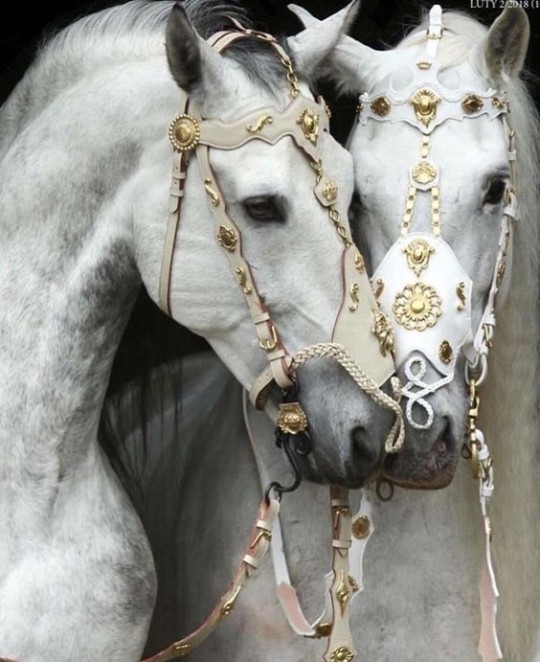
The deities assigned to Ashwini are Ashwini Kumaras_twin horsemen, depicted as young, healthy and handsome men who can heal people.

Like their power, Saule is associated with healing, regeneration and also fertility. She rides in her copper-wheeled carriage with her trusted horses, flying through the sky every day, bringing light and warmth to Earth. In regards to her appearance, she's frequently depicted with long golden hair, as well as being associated with gold and amber in general. She's described as being dressed in golden silk. Being the goddess of health and vitality, she had horses that would never tire nor sweat.
At night Saule would bathe her horses and go to the underworld. She was married to the moon god Menesis. Their first child was Earth, then followed other children: the Stars. It's said that her husband was very carefree, sometimes sneaking out of their castle in his moon carriage, thus leaving the world to darkness. Despite having a husband, ultimately, Saule is a sovereign and independent goddess.
As the setting sun, Saule is known as the falling red apple, a ring or a crown. She's strongly associated with the color red, and also apples and apple trees. Other plants associated with her are daisies, sunflowers, roses and linden.
Saule is honored every year at summer solstice.

I want to talk a little about why I coorelated her to Ashwini but first, I'll talk about the goddess extremely similar to her- Norse goddess Sol/ Sunna. She's also associated with the sun, healing, regeneration and has a chariot pulled by two horses, one of which is called Allsvinn (very fast), the other is called Arvak (early rising). Also, one of her many names literally means "Gold".
I think the association of these goddesses with Ashwini kumaras is clear, but I chose the Baltic goddess saule as to me the Baltic culture is more similar to Ashwini's energies than the Norse (You'll definitely see Norse goddesses in this series tho). Baltic people also have gods which are basically their equivalent of Ashwini Kumaras, twin horsemen gods called Ašvieniai. It's crazy to me that two cultures that you wouldn't think have anything in common basically share a deity.
Other deities that can be associated with Ashwini other than Saule:
Sunna- Norse goddess of the Sun, healing and fertility.
Ašvieniai- Baltic twin horsemen gods who have a gift of healing
Rhiannon- Celtic goddess known as "The Horse Queen", goddess of movement, leadership, the night, the moon and death.
Epona- Celtic goddess most strongly linked to horses (and you can tell by her name)
That's it for Ashwini🤍❤ I love my horse- people😅🤍 I genuinely do, there's no one like you guys, you are very healing and refreshing to be around. Keep going 🐎🐎
Don't forget to comment if u liked this or you can interact in any way .
#ashwini#ashwini nakshatra#baltic mythology#saule#goddess saule#nakshatras#vedic astrology#ashwini kumaras#sun goddess#sun in ashwini#moon in ashwini#ascendant in ashwini#moon in ashwini nakshatra#sun in ashwini nakshatra#ascendant in ashwini nakshatra#ketu in ashwini#ketu in ashwini nakshatra
108 notes
·
View notes
Text
The Celtic Goddess Danu - the Mother Goddess, the goddess of and manifest divine waters. The waters that fell from heaven to create the sacred river, Danuvis or the Danube.
The Tuatha De Danaan are translated as "The Children of Danu."

There are similarities here between this Ganga and the forming of the Ganges. But more notably, Danu from Hindiusm - the primordial mother goddess of ancient/first old waters - liquid. There is also a river named Danu in Nepal.
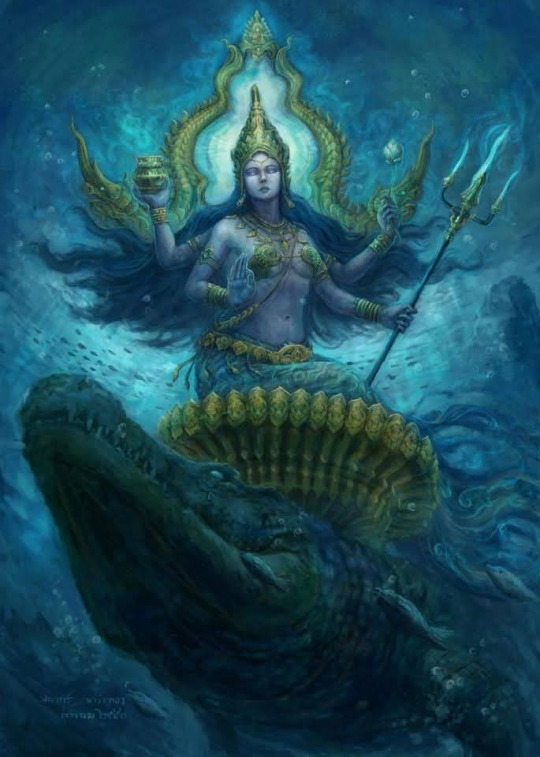
She is the mother of the Danavas, a larger category of the Asuras - celestial/supernatural beings of god like powers, but calling them gods exactly is incorrect. Asuras and Devas are larger in some ways than that - celestial/cosmic beings of princely domains/abilities is slightly more accurate, but for all intents an purposes. There are more similarities between Celtic and Vedic/Hindu culture/myths.
Why?
Well, recent research has shown Celtic genetics shows paternal and maternal ancestry from ancient India (R-M269 deriving via R1b, and H & U haplogroups) - is it really that weird then we see echoes of the ancient Indian epics echoed throughout other parts of the world, especially with the history of Eurasian/South Asian trade, migration, and more?
There is a story well known in the South Asian stories, but let's talk about the similar Celtic one. A tale of how a hero has to build a causeway across the waters to reach his foe, and how his wife must outsmart her captor/villain.
Some Indians are already nodding their heads. We begin with the Celtic hero: Fionn mac Cumhaill, a hero who is born just after his father dies.
Does this sound somewhat familiar?
Well, here we have Rama, born to Dasaratha, who is cursed to die soon as his son leaves him. His father dies as soon as Rama is exiled from Ayodhya.
Finn goes on to study with poets, warriors, and hunters in the forest of Sliabdh Bladma.
Rama goes to the forest hermitage where he learns similar arts under Vasitha.
Finn later in his youth goes on to destroy the fire breathing demon Áillen of the Tuatha (Children of Danu analogous of Aditi here btw) who destroys the capital of Tara every year on Samhain (a celebration very similar to the Indian Pitru Paksha btw)
Rama as a teen kills the Asuras attacking the hermitage - the enemies of the Devas (children of Aditi), interestingly enough just like I've talked about in the Norse (how you have two bodies of celestial/god beings - Aesir and Vanir), the Greeks have it, there is also a flipping that happens in a lot of these ancient cultures.
Aesir and Asura come from the proto indo European asr - but in one group one is good, the other bad. However in the Iranian - Zoroastrian, there is a reverse. The Ahura (Asura) are GOOD and the Devas are bad (down to including Indra from South Asian mythology), and in the Celtic we see something similar - a flipping of roles.
Rama, Sita, and her protector Lakshmana were all in exile together in the forest. The demon king Ravana sends a golden deer to tempt/seduce and lure away Sita from Rama but it is really the demon Maricha in disguise. Sita is tricked and ends up sending her protector to Rama, leaving herself vulnerable, and thus abducted by Ravana who wishes to marry her and this leads to a war in where Rama eventually gets her back also, kidnapping of a women sparking a war? OH HI, HELEN OF TROY. HI.
Fionn meets his wife Sabadh while hunting, and guess what? She is turned into a deer by a druid she refuses to marry. She returns to her true form once in Fionn's home and they marry...only she's turned into a deer again by the druid Fear Doirich when Fionn was off at war, and Fionn must spend years searching for her. Wow. Coinky dinky dinky.
Now to the original part of my talk here, the causeway in Ireland was built by Fionn to travel to battle a giant. Rama Setu, his causeway, was built by Rama's army so he could enter Lanka to do battle there - (Sri Lanka).
The Celts also have four major cycles of time just like the Vedic Indians did. The tricky thing here is that linguistically, PIE (proto Indo European) has been shown to be behind a lot of story/cultural influences as it spread through Europe/Asia, but...the thing that's hard to account for here is how geo-located Ramayama is in/to India, so why do specific echoes of it show up in Celtic mythology so much so?
Yay comparative mythology and echoed storytelling/beats tropes across the world.
#celtic folklore#celtic lore#celtic stories#Tuatha De Danaan#Ganga#Danu#the ganges#Asuras#Celts#fionn mac cumhaill#south asian mythos#south asian#myths and legends#hindu mythology#hindu gods#hinduism#india#Áillen of the Tuatha#Ireland#irish folklore#irish mythology#celtic mythology#gods and goddesses#gods and monsters#god stories#storytelling#folklore#folktales
13 notes
·
View notes
Text
psst, psst, hey kid. look over here.
yes, that's the iliad. yes, it's in mycenaean greek (reconstructed), like how we have reconstructed proto-indo-european versions of folktales. rob wiseman translated the first 100 lines of the iliad and shows exactly how he did it by utilizing different text colours according to whether or not the root is unable to be reconstructed past that point, if the word occurs in linear b but without a secure etymology, or if the word is an unreconstructable term (probably not of indo-european descent).
then he goes and writes it out in what the linear b syllables would be.

(if you don't have a scribd account, there are other perfectly cromulent ways of downloading documents from there, simply found by searching)
10 notes
·
View notes
Note
hi! i love love love linguistics and semiotics, but i dont know what resources to search to deepen my knowledge. Ive gotten a lot of your posts recommended, you seem very well infomed, so i wanted to ask if you had any recommendations. Sorry to bother!
The question is, 1) what are you looking for in terms of tone/accessibility (popular, introductory-but-rigorous, very technical), and possible subfields of interest, and 2) what amount of background knowledge do you have already?
I started learning about linguistics when I was a hip young teen through the lens of conlanging, and a book like Mark Rosenfelder's Language Construction Kit is, I think, a pretty decent introduction to the basics of both, if you're really starting at zero. If you want an introductory overview of historical linguistics specifically that is more rigorous, maybe Lyle Campbell's Historical Linguistics, 3rd edition. If you're interested in the history of the English language specifically, maybe The History of English, by Stephen Gramley. Glancing at my bookshelf, I might also suggest Indo-European Linguistics by James Clackson (if Indo-European interests you! Rigorous, but not overly difficult), and Linguistics, 5th edition, by Akmajian, Demers, Farmer, and Harnish (which is just a straight-up textbook). With some persistent Googling, you may be able to find most of these as pdfs online.
I have always been more interested in historical linguistics than syntax and other more synchronic topics, and what I've read reflects that (though I do have a volume called Historical Syntax someone gave me that I haven't gotten around to yet!), and I know very little about semiotics beyond Saussure and the Course in General Linguistics material covered in my Critical and Cultural Theory course in university, so I'm afraid I don't have anything useful to recommend there.
If anyone has any better recommendations to suggest, please do.
21 notes
·
View notes
Text
A new language database narrows search for the first speakers of Indo-European
Using an improved dataset, a team of linguists and geneticists have updated their model of how we think the Indo-European languages spread.
You can compare their new model with the former Kurgan hypothesis in these two maps:
The Kurgan Hypothesis (previous widely-accepted theory)

The Fertile Crescent Hypothesis (new theory)

The two biggest changes are:
An earlier date (8,100 YA or 6,100 BCE) for Proto-Indo-European, the language from which all Indo-European languages descend.
A homeland near the Fertile Crescent, followed by later expansions into Anatolia and the Pontic-Caspian Steppe.
If true, this would date the Indo-European language family to a thousand years older than previous estimates.
It also neatly combines the two previous most prominent hypotheses—the Anatolian hypothesis (claiming that Indo-European originated in Anatolia), and the Kurgan hypothesis (claiming that Indo-European originated in the Pontic-Caspian Steppe). Under this new model, Indo-European originated further south, then spread to each of those two regions at a later date.
Here’s some more coverage from Phys.org:
And you can peruse the open access database yourself here:
Want to learn more about the history of Indo-European? My book rec on this topic is “The horse, the wheel, and language”:

35 notes
·
View notes
Text
You know...If Demyx's correct name is Demy (simply adding the X to the end in order to continue playing the role of the lazy guy), it could be a variation of Demi which means "follower of Demeter". She's a notable mother figure that searched everywhere for her missing daughter until she's informed that Persephone was taken into the Underworld to which Demeter starts to neglect her duties as a god.
And in a Homeric Hymn, it's said she adorned a black cloak as she searched for her missing daughter.


This could explain why the first time we see Demyx is inside the Underworld, not really seeming to be doing anything productive for the Organization. It's never made clear what his mission was, if he was given one at all, or if he was merely acting on his own.

And the second part of Demeter's name, meter, is derived from the Proto-Indo-European term *méh₂tēr which means...mother. Hades summons who he calls the "mother of all bad guys" in the same exact visit that Demyx shows up in.
15 notes
·
View notes
Note
You made a comment on Feb 12 in regard to a goy being an ass and said the nazis were pagans. Which surprised me because I know theres a neo-pagan movement today and such but overall could you elaborate?
In order for Nazism to gain traction, Hitler, and Himmler specifically, needed a faith system in order to unite the German people. They took elements of historic Nordic and Germanic pagan belief and archaeology- Nazi archaeology relied on trying to convince the world that there was an indeed an ancient race of Aryans and that Germans were their descendents. They appropriated Nordic and Slavic sites, claiming they were in fact Germanic, and sometimes even faked discoveries.
Himmler especially wanted to impose his idea of "true Germanic paganism" onto the German people in order to distance themselves from Christianity and create more of a "unique" identity that seperated Germans from other Europeans, to unite them under a shared Volk identity. He also was obsessed with religious relics that he claimed were of German origin, or could at least give legitimacy to the Nazis by being symbols of power. One of the things he tried to popularize was the concept of Thingspiel, which he claimed was based on ancient Germanic pagan celebrations. The Nazis built amphitheatres on sites they claimed were the ancient sites of Germanic pagan gathering sites, although some sites were pure fabrications.
Most Nazi symbols are taken from Nordic runes or, in the case of a swastika, from symbols they found in archaeological sites that they believed was proof of a universal Aryan race. In reality, swastikas were just a simple symbol to draw and often depicted a star or the sun in archaeological finds. There's been swastikas found in archaelogical sites around the world. Neo-Nazis today rely on their idea of Germanic paganism, and the modern Norse pagan community is unfortunately rife with Nazis.
Further reading:
Producing the Volk community – the Thingspiel movement 1933–36
'Arierdämmerung': Race and Archaeology in Nazi Germany
The Past as Propaganda: Totalitarian Archaeology in Nazi Germany
Hitler’s Monsters: The Occult Roots of Nazism and the Emergence of the Nazi ‘Supernatural Imaginary’
LUCIFER’S COURT: Ario-Germanic Paganism, Indo-Aryan Spirituality, and the Nazi Search for Alternative Religions
ASATRU FOLK ASSEMBLY
The Man Who Brought the Swastika to Germany, and How the Nazis Stole It
A LOOK AT RACIST SKINHEAD SYMBOLS AND TATTOOS
Runic Writing (racist)
Cultural Appropriation in Contemporary Neopaganism and
Witchcraft
#antisemitism#racism#white supremacy#history#nazis#heinrich himmler#pagan antisemitism#pagan racism#nazi symbols#nazi ideology#neo nazis
145 notes
·
View notes
Text
A Spell for the Honey Eaters
Introduction
In a lot of Slavic languages we see the word for “bear” (the animal) being formed from epithets. In Russian, the modern word for “bear” is transliterated as “medved.” That, along with the Polish “niedzwiedz” both translate roughly to “honey eater.” This same use of epithets is demonstrated in a lot of Germanic and Scandinavian languages—the Old Norse “bjorn,” the less-common English word “bruin,” and even the German “baer” all ultimately refer to the animal’s color: brown. Indeed, this use of epithets for the animal was so widespread in the ancient north that, according to The Linguistics Encyclopedia (2002) we now have no record of what the actual name for the winter sleeper was in any northern Indo-European dialect.
But why did this taboo exist against saying the name of the honey eater? Until effective post-mortem communication is established everything is speculation, of course, but the most common consensus on this issue among paleo-linguists is that the people of the ancient north were very… let us say respectful of honey eaters. Nobody wanted the winter sleepers to steal their kills, raid their camps, or—worst of all—actively hunt them. Bears (let us be brave with this name) have power; they are massive, strong, and deadly apex predators.
Who are also very cute!
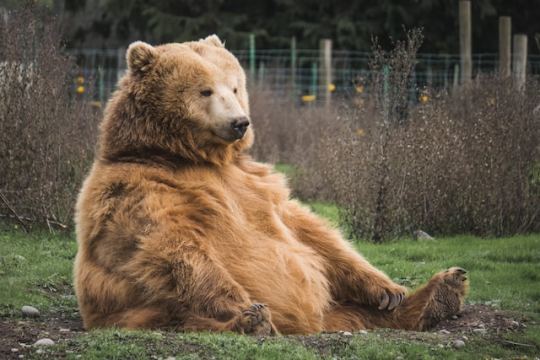
photo by Mark Basarab on Unsplash
Bears also get very fat every autumn and then sleep through the winter in order to avoid the problem of otherwise not having enough food available through the lean months of the year. Smart! But also fat. Very, very fat. So fat, in fact, that the United States National Park Service hosts an annual contest called Fat Bear Week where people can vote on their favorite bear every autumn. The linked website says it best:
“For bears, fat equals survival. Each winter, bears enter the den where they will not eat or drink until they emerge in spring. During this time, they may lose up to 1/3 of their body weight as they rely solely on their fat reserves. Survival depends on eating a year's worth of food in six months.”
So what does this mean for us humans? It means… stop hating yourself and/or others for being fat. This spell uses the spirit of the bear as an animal ally (if you are white like I am, please do not use the term “totem” or “spirit animal” due to those terms being cultural appropriation) to inspire yourself towards a better sense of self-love when it comes to your weight. And if you really struggle with internalized fatphobia, then you can at least use this spell to see yourself in a more neutral way that doesn’t reflect negatively on your self-worth.
Method
When pondering the nature of the primordial winter sleeper, I was initially drawn to food-focused witchery—because is it really a spell channeling the power of bears if you don’t eat at least one salmon? (this is a joke)—but this isn’t always an accessible option for people who struggle to cook and/or have a history with eating disorders. Therefore, the goal with the honey eaters’ spell is to nourish your body—but not necessarily with food if that doesn’t work for you. Therefore, more specifically for this spell you need to give your body what it needs to not just survive, but thrive.
And you know your own body infinitely better than I (a rando on the Internet) certainly do, so you get to decide what exactly your body needs to thrive. It could be 8+ hours of sleep, a solid meal, and/or an extra bottle’s worth of of water throughout the day… but these are just the basics. Maybe you need something more complex than that. Maybe you need a lot more than that. That’s okay. It’s okay to need things, and also okay to want things that aren’t necessities. It’s okay to pursue the things you want and/or need, like a bear tearing through a blackberry patch in search of the ripe, tart fruit. If you feel like you need permission to go after what you want, this is your sign to give chase with all of your power.
Please keep in mind that this spell lasts 24 hours once begun.
You will need:
Writing supplies OR a method by which to digitally store an image and quickly/frequently refer back to it
Accouterments for self care (your choice & discretion)
Instructions, such as they are:
First, draw a picture of a bear with your writing supplies. It doesn’t need to be fancy! Arguably one of the most famous pictures of a bear ever made was created more than 30,000 years ago in a cave called Chauvet in France. It looks like this:

photo by Jean Clottes, retrieved from Smithsonian Magazine
(If you want to learn more about the cave paintings of Chauvet, you can do so here).
If you don’t have the spoons to draw, lack confidence as an artist, or otherwise just don’t want to draw a picture, you can find a picture of a bear online and save it to your phone or another device for quick/frequent reference. Remember the power of the honey eater as you do so, and know that you are keeping that power close to you throughout the day that this spell will last. The attention of the winter sleeper is upon you, and though not cruel the honey eater will ask that you be kind to yourself; winter is never too far away, and you need your strength to survive the cold.
Once your image of a bear has been created or saved, the spell is begun. For the next 24 hours, your mission as a magical practitioner is to ensure that your body thrives. Take care of yourself as much as you are able; live lavishly, indulgently, and without regret. If you ever find yourself caught in a sudden trap of shame or doubt, think of the honey eater—refer back to your image if necessary—and say an epithet or name for "bear" that feels comforting to you (some examples: Arktos, Ursus, Medved). You can say the name aloud or just think it really hard; the point of doing this is to interrupt the shame/doubt and not allow it to take root and fester in your mind and heart. Keep doing this until the 24 hours are finished. Repeat as you see fit.
The purpose of this spell is to help your body and mind escape negative patterns of behavior and thought through the power of the winter sleeper. Remember that bears are fat, and that bears were some of the most awe-inspiring and terrifying animals ever encountered by ancient humans. There is nothing wrong with being fat, and fat is often necessary for survival through the long, hard months of winter. Unlike bears, we can’t sleep away months of darkness and cold—whether that darkness and cold be mental illness, abuse, or something else entirely—but we can bring the strength of the honey eater into ourselves for the eternal quest to continue living until the next spring.

If you liked this spell or even just found it intriguing, please consider checking out my ko-fi where I share spells and witchcraft-focused zines. As a struggling college student in an abusive home, it means a lot when someone is able to toss some spare change my way!
#witchcraft#witchblr#witches of tumblr#magic#haven's original spells#spellcraft#animal magic#fat acceptance#fat liberation#body positivity
17 notes
·
View notes
Photo
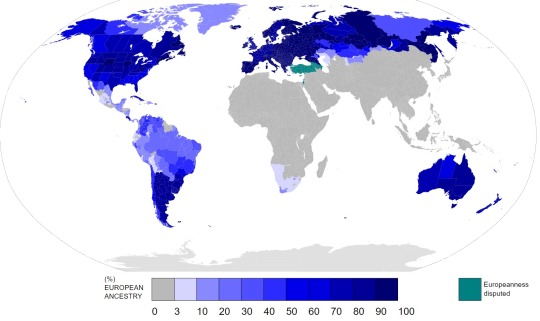
Map of percentage of people with European* ancestry, largely based in Ethnic self identification in censuses and in a broad ethnoreligious approach.
The very concept of "European peoples" is contested. "Europe" itself is not a geographical accurate term, given the fact that the borders between Europe and (specially) Asia are historical, cultural and political more than physical. Read more here: https://en.wikipedia.org/wiki/Boundaries_between_continents#Europe_and_Asia
In the latest version of this map I'm considering all ethnic groups with an European homeland since at least several centuries as "Europeans". So all North Caucasus peoples, Bosniaks, Albanians are considered Europeans.
Georgia, Armenia, Azerbaijan, Turkey, Cyprus and Israel are shaded in turquoise due to lack of consensus in their "Europeanness".
Some groups in the Ural/Volga border as the Nenets and the Kalmyk peoples are not considered Europeans due to their strong historical ties to Siberia and Mongolia, but this is debatable.
West Afroasian Christians as Egyptian Copts and Arab Christians are not considered European.
Mixed race people: different criteria so explanations are given. Mixed race people are often counted separately in many censuses and follow the one drop rule (one drop of non European blood means that people is out of the European ancestry group and into the Mixed ancestry or even African/Asian group). Whenever this is the case, I just follow the census country criterion. For example, the USA follow the one-drop rule, so African-Americans with 20% African ancestry and 80% European would count as 0% European ancestry in this map). Given the fact "Mestizo" and "Colored" are separate categories in many censuses (in Latin America or South Africa) from "White" or "European", I'm considering those 0% European ancestry despite the fact those people probably have European ancestry, because of lack of genetic data (the answer to questions like "are Mestizos 10% European or 90%?" is really hard to find in many countries, so I'm being conservative). Other issue can be found in how people identify themselves in Latin American and other mixed-race countries: a 80% Amerindian 20% European mixed race population self identified as "White", "Caucasoid" or "European" is counted as 100% European ancestry in this map. So numbers are sometimes inflated, and sometimes reduced to some point. Obviously no massive DNA analysis are performed in censuses so we rely on the information they gather based in self identification and this map has to be read in that way. Anyway, I'm not using the one-drop rule, but the genetic admixture rule, in some cases when the census is not explicit about this and I have to take a decission AND I happen to have genetic precise data: for example, mixed Asian-European groups in Russia (like Mari people) are counted as (for example) 30 to 70% European ancestry following genetic studies on Mongoloid admixture (which I managed to find) in every Eurasian ethnic group . Also check the sources for more information, a lot of data is gathered from the European Diaspora article so I'm not deeply following every link, but just assuming that data is acceptable and accurate in a broad sense. Ask the original editors of this article for further information. Anyway, numbers and percentages probably don't change so much after all these calculus, so the map is correct in general (maybe take a +-10% error in Eurasia and +-20/30% in Latin America, where ancestries are much more mixed). In Chile, lack of self identification ancestry in censuses led me to search genetic data as well.
This is NOT a map of the White race, just an "European ancestry" map. Thats the reason North African, Middle Eastern and Indo-Iranian peoples majority territories are not shaded. Anyway, some countries don't specify the origin of "White people" in their censuses so I'm taking "Caucasian" and "White" self identified people in censuses mostly in countries in the Americas as having "European ancestry", so Lebanese ancestry people in Colombia or Morocco ancestry people in the USA are counted as "European ancestry" peoples in this map because of lack of data. Despite of that, numbers and percentages wouldn't be so different considering those details and I encourage everyone who is reading this to do the math and realize these facts.
To sum it up all, generally conservative criteria are taken: the geographical criterion (Middle Eastern Christians and Indo-Iranians are not considered European because their historical roots are in zones of the Asian continent) or the census one-drop-rule criterion (Mixed race peoples with lack of genetic data are not considered European). With other and broader criteria, the map would be completely different and it could be redrawn.
Kurds, Iranians and Kazakhs are not considered here Europeans as ethnic groups that are related or belong to Asian territories.
Source base map: File:Blank_Map_World_Secondary_Political_Divisions.svg
My original sources were a mixture between data in the article ( https://en.wikipedia.org/wiki/European_diaspora ) where the map is, and in countries where the information is detailed enough are taking numbers from censuses from the Russian Wikipedia for all the provinces, oblasts, autonomous regions, etc(see below), censuses from the USA 2010 (numbers listed in https://www.census.gov\/prod/cen2010/briefs/c2010br-05.pdf https://en.wikipedia.org/wiki/White_American ), Australian 2011 census http://www.abs.gov.au/census , and Canada (numbers listed in https://en.wikipedia.org/wiki/Demographics_of_Canada ), and taking into account the number of non-European migrants in the countries of the EU https://en.wikipedia.org/wiki/Immigration_to_Europe .
Kazakhstan: Each province was searched, I went to the russian article where ethnic compositions are given (in Russian). For example, the Akmola region: https://en.wikipedia.org/wiki/Regions_of_Kazakhstan https://ru.wikipedia.org/wiki/%D0%90%D0%BA%D0%BC%D0%BE%D0%BB%D0%B8%D0%BD%D1%81%D0%BA%D0%B0%D1%8F_%D0%BE%D0%B1%D0%BB%D0%B0%D1%81%D1%82%D1%8C Same with the rest (take all the provinces, look for them in the Russian wikipedia, etc): https://ru.wikipedia.org/wiki/%D0%90%D0%BA%D1%82%D1%8E%D0%B1%D0%B8%D0%BD%D1%81%D0%BA%D0%B0%D1%8F_%D0%BE%D0%B1%D0%BB%D0%B0%D1%81%D1%82%D1%8C https://ru.wikipedia.org/wiki/%D0%90%D0%BB%D0%BC%D0%B0%D1%82%D0%B8%D0%BD%D1%81%D0%BA%D0%B0%D1%8F_%D0%BE%D0%B1%D0%BB%D0%B0%D1%81%D1%82%D1%8C I continued with the rest. Russia: http://pop-stat.mashke.org/russia-ethnic2002.htm Brazil: File:People_of_European_Ancestry_in_Brazil.png
Bosnia-Herzegovina: https://en.wikipedia.org/wiki/Religion_in_Bosnia_and_Herzegovina
Kosovo: https://en.wikipedia.org/wiki/Demographics_of_Kosovo#Religion
Albania:
https://en.wikipedia.org/wiki/Religion_in_Albania
Venezuela: https://en.wikipedia.org/wiki/Venezuelan_of_European_descent#White_Venezuelan_population_by_Venezuelan_state
Colombia: https://es.wikipedia.org/wiki/Etnograf%C3%ADa_de_Colombia#Blancos
This numbers are for "blancos+mestizos", as Brazil and Venezuela separate White and Mixed peoples in separate categories, I do the same here correcting this numbers using a 0,43 coefficient according to "The 2018 census reported that the "non-ethnic population", consisting of whites and mestizos (those of mixed white European and Amerindian ancestry, including almost all of the urban business and political elite), constituted 86 percent of the national population. The 87 percent figure is subdivided into 47 percent mestizo and 40 percent white " https://en.wikipedia.org/wiki/Race_and_ethnicity_in_Colombia#cite_note-3
Mexico: Censo de 1921 http://www.inegi.org.mx/prod_Serv/contenidos/espanol/bvinegi/productos/censos/poblacion/1921/EUM/RCGH21I.pdf
Quite old but good approximation, mixed race people is excluded as in Brazil, Venezuela and Colombia due to lack of genetic data. Modern Mexican censuses do not provide ancestry data.
Bolivia: http://bolivia.unfpa.org/sites/default/files/Censo_Poblacion_1900_T2.pdf
Old Census but the last one including ethnic selfidentification, probably numbers are not so different today.
Cuba: http://www.one.cu/publicaciones/cepde/cpv2012/20131107resumenadelantado/tablas/4.pdf
Peru: http://espejodelperu.com.pe/Poblacion-del-Peru/index.htm
guided by http://www.forosperu.net/temas/composicion-etnica-y-racial-del-peru-por-departamentos-actualizado.210657/
Ecuador: http://www.ecuadorencifras.gob.ec/resultados/
Chile: http://www.scielo.cl/scielo.php?script=sci_arttext&pid=S0034-98872014000300001&lng=en&nrm=iso&tlng=en
Turkey: https://en.wikipedia.org/wiki/Demographics_of_Turkey
Azerbaijan: https://en.wikipedia.org/wiki/Ethnic_minorities_in_Azerbaijan
Argentina:
https://www.researchgate.net/publication/317552097_Admixture_in_Argentina?_iepl%5BviewId%5D=7mgiM9aS1rLkhmJH6Fx6jHsg&_iepl%5BprofilePublicationItemVariant%5D=default&_iepl%5Bcontexts%5D%5B0%5D=prfpi&_iepl%5BtargetEntityId%5D=PB%3A317552097&_iepl%5BinteractionType%5D=publicationTitle
167 notes
·
View notes